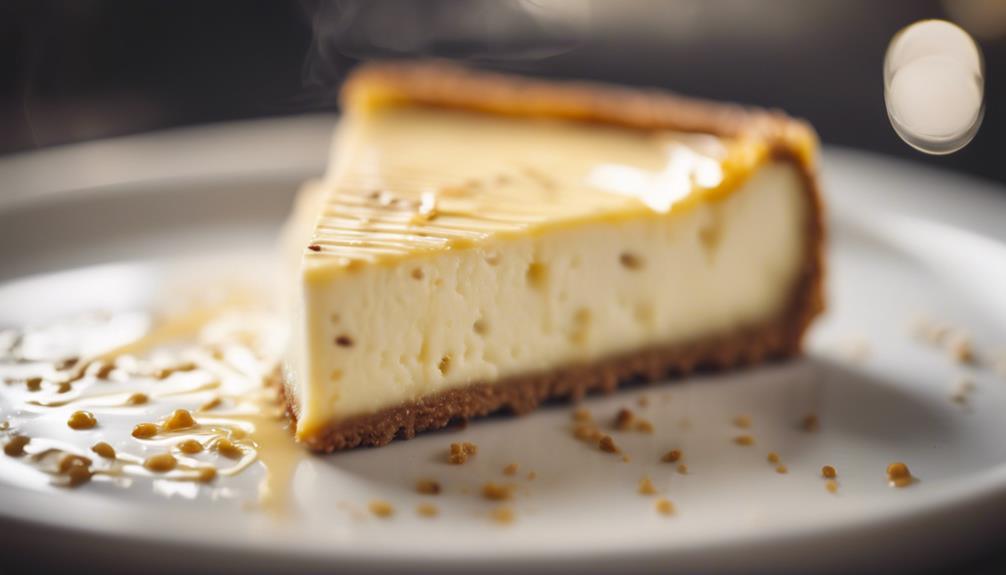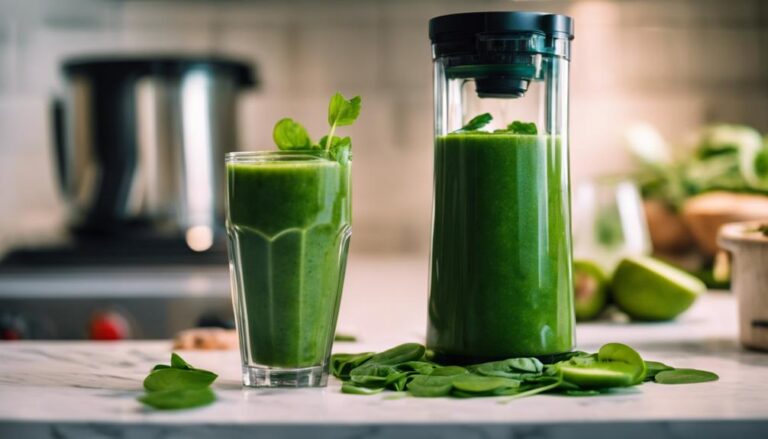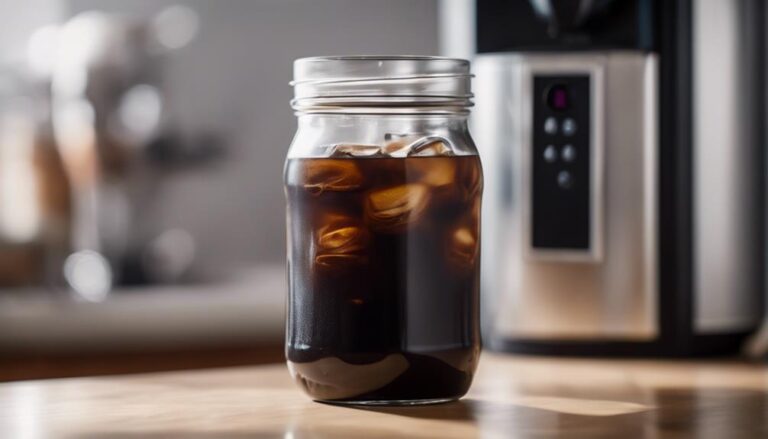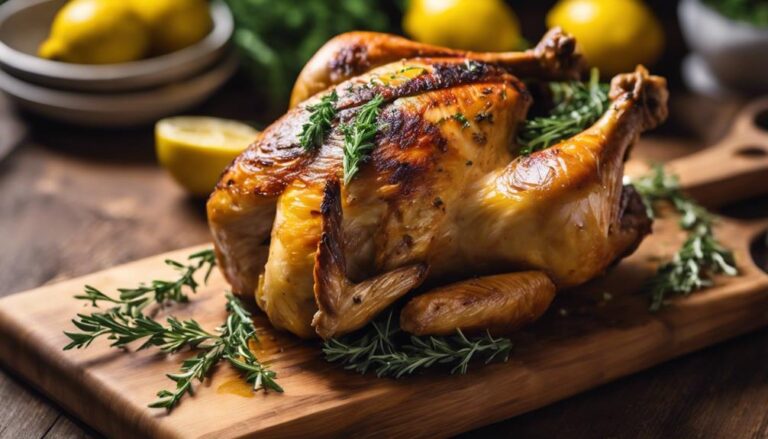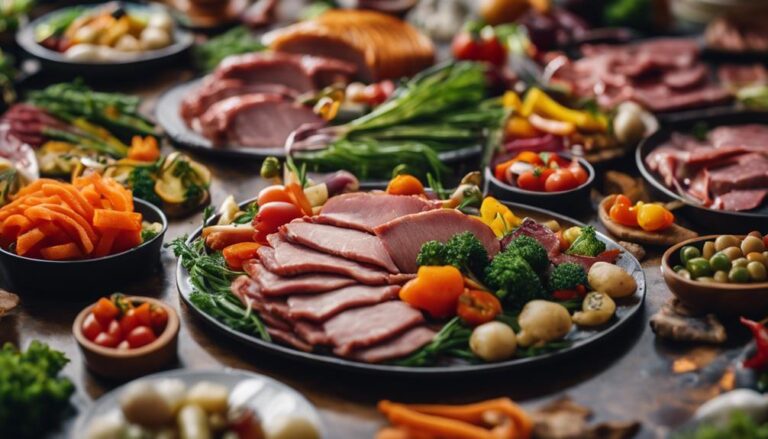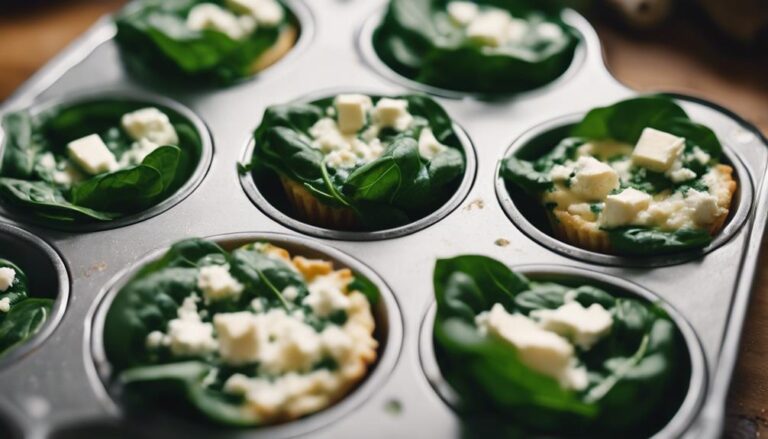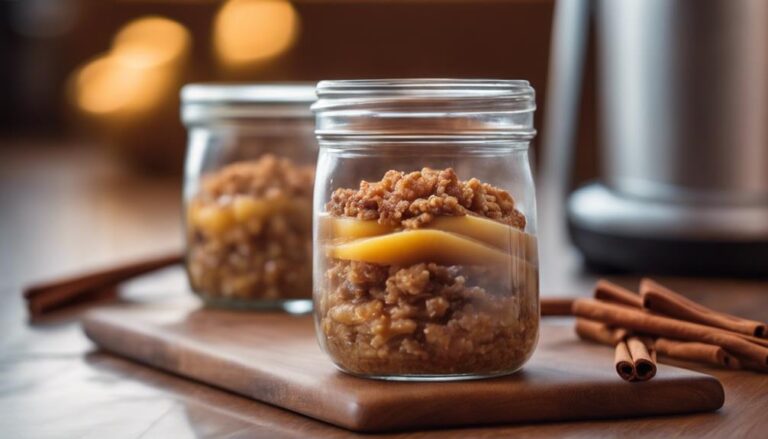Sous Vide Vanilla Bean Cheesecake
Indulge in the exquisite taste of Sous Vide Vanilla Bean Cheesecake, where precision cooking transforms this dessert into a decadent masterpiece. The creamy texture infused with the rich flavor of vanilla beans creates a harmonious balance of sweetness. The sous vide method guarantees even cooking, preserving the velvety consistency without risk of overcooking. Topped with a dusting of cocoa powder or powdered sugar, each bite is a luxurious experience. If you want to uncover more about this revolutionized classic dessert, discover the intricacies of flavor development, ingredient mixing tips, and other baking techniques for the perfect cheesecake.
What You Will Learn Here
- Sous vide cooking ensures precise temperature control for perfect cheesecake texture.
- Infusing vanilla beans enhances flavor depth and richness in the cheesecake.
- Vacuum sealing cheesecake ingredients maintains moisture and prevents air bubbles.
- Slow cooking in a water bath guarantees even heat distribution for a creamy consistency.
- Sous vide method minimizes the risk of overcooking, resulting in a silky smooth dessert.
Cheesecake Evolution
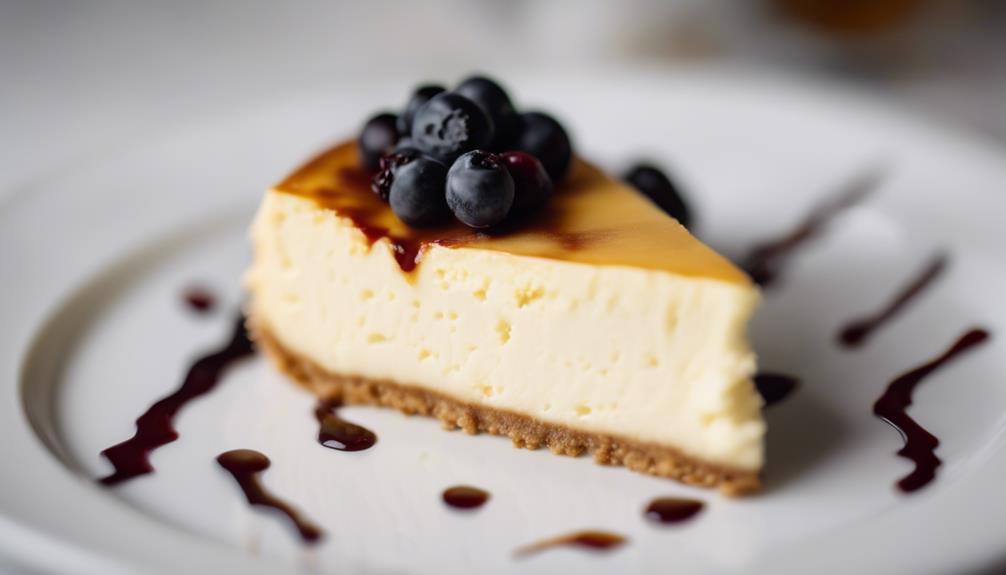
As you consider the evolution of cheesecake, think about its humble beginnings and how it has transformed into a dessert with endless variations.
From its ancient origins to the innovative flavors of today, cheesecake has come a long way.
Analyze the trends that have shaped the cheesecake landscape and how they continue to influence modern recipes.
Cheesecake Recipe Origins
The evolution of cheesecake recipes showcases a rich history of culinary experimentation and innovation. Cheesecake origins date back to ancient Greece and were later adopted by the Romans, evolving into a dessert enjoyed worldwide. The development of cheesecake recipes has been influenced by various cultures, leading to a diverse range of flavors and textures. Below is a table highlighting key aspects of cheesecake recipe origins:
| Cheesecake Origins | Culinary History |
|---|---|
| Ancient Greece | First recorded mention of cheesecake. |
| Roman Empire | Spread of cheesecake across Europe. |
| Middle Ages | Introduction of cream cheese in recipes. |
| New York | Birthplace of the modern cream cheese cheesecake. |
| Global Influence | Fusion of flavors from different cuisines. |
Modern Cheesecake Variations
Cheesecake recipes have evolved over time, showcasing a diverse array of modern variations that cater to evolving tastes and culinary trends. Cheesecake presentation has become an art form, with bakers experimenting with unique molds, layers, and decorations to create visually stunning desserts.
Flavor combinations have also taken a bold turn, incorporating unexpected ingredients like matcha, lavender, or even bacon to add exciting twists to the classic treat. The introduction of sous vide cooking has revolutionized cheesecake making, offering a precise and consistent method that results in a velvety texture and rich flavor.
Dessert experimentation knows no bounds, pushing boundaries with avant-garde creations like savory cheesecakes or liquid nitrogen-frozen variations, appealing to the adventurous palate of modern food enthusiasts.
Trendy Cheesecake Flavors
Indulge your taste buds with an intriguing array of innovative flavors that have redefined the traditional concept of cheesecake. Cheesecake evolution has led to a delightful exploration of unique flavor combinations like matcha green tea, salted caramel apple, or even lavender honey. These modern twists bring an invigorating twist to a classic dessert, appealing to adventurous palates seeking new culinary experiences.
Presentation ideas have also taken a creative turn, with cheesecakes now being served in individual mason jars, mini cupcake sizes, or even deconstructed on elegant platters. The evolution of cheesecake flavors has opened up a world of possibilities, allowing for endless experimentation and customization to suit every taste preference.
Cheesecake Base Ingredients
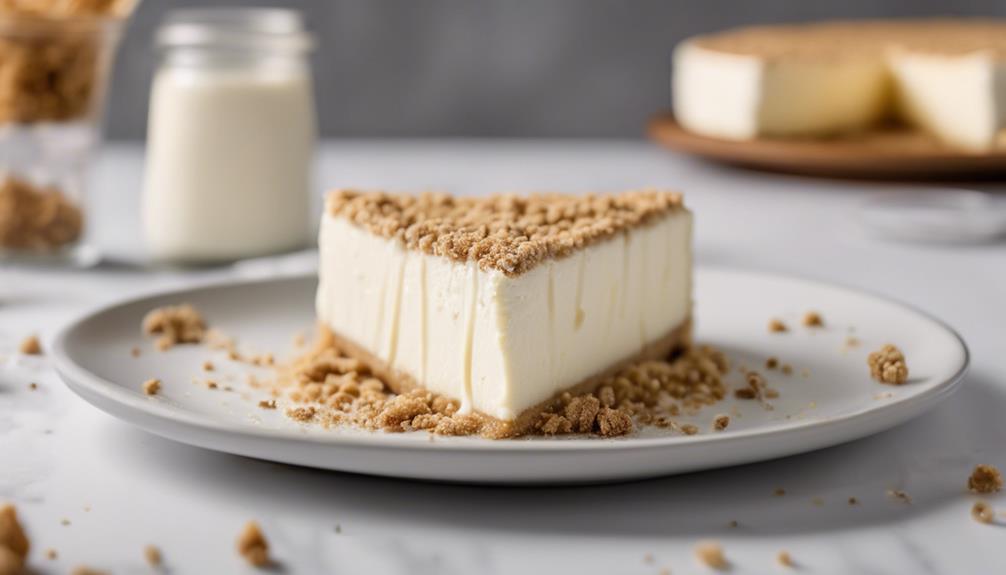
Consider blending together graham cracker crumbs, melted butter, and sugar to create a flavorful and sturdy base for your cheesecake. This foundational layer sets the stage for the creamy filling to shine. Achieving the perfect balance of sweetness and texture in your cheesecake base is essential for a delectable dessert experience.
- Graham Cracker Crumbs: The key component for a classic cheesecake base, these crumbs provide a deliciously crunchy texture.
- Melted Butter: Acts as the binding agent, ensuring that the base holds together well when sliced.
- Sugar: Adds sweetness to the base, complementing the tanginess of the cream cheese filling.
- Vanilla Extract: Enhances the flavor profile, giving a subtle aromatic note to the base.
- Salt: A pinch of salt can elevate the overall taste by balancing the sweetness and enhancing other flavors.
Trending Cheesecake Variations
Explore the delightful world of cheesecake variations with these trendy options:
- Vanilla Bean Infusion Cheesecake for a rich and aromatic twist
- Blueberry Swirl Cheesecake for a burst of fruity flavor
- Lemon Zest Cheesecake for a zesty and invigorating experience
Each variation offers a unique and exciting take on the classic dessert, perfect for adding a touch of creativity to your baking repertoire.
Elevate your cheesecake game with these contemporary flavors that are sure to impress your taste buds and guests alike.
Vanilla Bean Infusion Cheesecake
Enhancing the classic cheesecake with the rich flavor of vanilla bean infusion is a delightful way to elevate your dessert experience. When experimenting with vanilla bean pairing, consider the following tips for a successful infusion technique:
- Quality Beans: Opt for plump and fragrant vanilla beans for the best flavor.
- Scraping Technique: Use the back of a knife to scrape out the flavorful seeds from the bean pod.
- Infusion Time: Allow the vanilla bean to infuse into the cheesecake mixture slowly for maximum flavor.
- Balancing Flavors: Adjust the amount of vanilla bean used to strike the perfect balance with other ingredients.
- Visual Appeal: Vanilla bean specks not only add flavor but also give a beautiful visual touch to your cheesecake.
Blueberry Swirl Cheesecake
To elevate your cheesecake game, explore the delectable world of Blueberry Swirl Cheesecake, a trending variation that promises a burst of fruity sweetness in every bite. Blueberry topping adds a pop of color and a tangy contrast to the creamy richness of the cheesecake. When considering dessert presentation, the vibrant swirls of blueberry create an eye-catching visual appeal that will impress your guests.
Here are some key points to keep in mind when making Blueberry Swirl Cheesecake:
- Incorporate a generous amount of blueberry swirls for a delightful burst of flavor.
- Make sure the blueberry topping is evenly distributed to achieve a balanced taste.
- Experiment with different blueberry compote consistencies to find the perfect texture.
- Use fresh blueberries when possible for a more intense and natural flavor.
- Consider adding a hint of lemon zest to enhance the fruity notes in the cheesecake.
Lemon Zest Cheesecake
Indulge in the invigorating allure of Lemon Zest Cheesecake, an exhilarating twist on the classic dessert that tantalizes your taste buds with bright citrus notes. The Lemon Zest Cheesecake offers a rejuvenating take on traditional flavors, perfect for those seeking a burst of vitality in every bite.
Here's why this trendy variation stands out:
- Lemon zest pairing: The combination of creamy cheesecake and tangy lemon zest creates a harmonious balance of sweet and sour.
- Flavor profiles: The vibrant citrus infusion elevates the richness of the cheesecake, creating a dynamic flavor experience.
- Citrus infusion: The use of lemon zest infuses the dessert with a fresh, invigorating aroma that awakens the senses.
- Dessert trends: Lemon Zest Cheesecake reflects the current shift towards lighter, fruit-forward desserts.
- Refreshing twist: This cheesecake offers a delightful departure from traditional flavors, perfect for those craving something new and exciting.
Cheesecake Baking Techniques
When baking cheesecakes, mastering temperature control is essential to achieve the perfect texture and prevent cracking.
Make sure to mix your ingredients thoroughly but avoid overmixing to maintain a smooth and creamy consistency.
Utilizing the water bath method can help in preventing the edges from overcooking and ensure even baking throughout the cheesecake.
Baking Temperature Control
While baking a cheesecake, maintaining accurate temperature control is essential for achieving the perfect texture and consistency. Temperature precision plays a vital role in flavor development, ensuring that the cheesecake bakes evenly without overcooking or cracking.
Understanding the baking science behind temperature control is key to achieving dessert perfection. To optimize your cheesecake, preheat your oven to the recommended temperature, usually around 325°F (163°C), and use an oven thermometer to verify accuracy.
Avoid opening the oven door frequently, as this can cause temperature fluctuations that may affect the baking process. Consistent temperature throughout the baking time will result in a creamy, velvety cheesecake that's sure to impress your taste buds.
Ingredient Mixing Tips
To enhance the flavor and texture of your cheesecake, mastering the proper techniques for mixing ingredients is vital in achieving a creamy and decadent dessert. When it comes to ingredient pairing and mixing, consider combining cream cheese with sugar first until smooth, then adding eggs one at a time to guarantee even incorporation. Be cautious not to overmix the batter to prevent air bubbles that can lead to cracking during baking. Incorporating vanilla bean paste or vanilla extract can greatly enhance the flavor profile of your cheesecake. Remember, gentle folding techniques when adding in sour cream or heavy cream will help maintain the desired velvety texture. Below is a table summarizing key ingredient mixing tips for your perfect cheesecake:
| Ingredient Pairing | Mixing Techniques | Flavor Enhancement |
|---|---|---|
| Cream Cheese + Sugar | Mix until smooth | Vanilla Bean Paste |
| Eggs | Add one at a time | Vanilla Extract |
| Sour Cream/Heavy Cream | Fold gently |
Water Bath Method
For best results in baking your cheesecake, consider utilizing the water bath method to guarantee even and gentle heat distribution during the baking process. Temperature precision is vital when using this technique, as it helps prevent overcooking or undercooking your cheesecake.
By setting up your equipment correctly, such as placing the cheesecake pan in a larger pan filled with hot water before baking, you make sure that the heat circulates evenly around the cheesecake, promoting a creamy texture and minimizing the risk of cracks on the surface.
Monitoring the cooking time is also essential to achieve the perfect consistency. The water bath method is a reliable way to create a velvety smooth cheesecake, making it a valuable technique to master for your baking repertoire.
Final Thoughts
Consider the flavorful journey you've just experienced with this Sous Vide Vanilla Bean Cheesecake, a delightful treat that showcases the magic of precision cooking techniques combined with the rich taste of vanilla. As you reflect on this culinary adventure, think about how you can elevate the experience even further. Experiment with different flavor pairings to complement the vanilla essence of the cheesecake. Perhaps a tart berry coulis or a caramel drizzle could add a new dimension to the dessert, enhancing its already exquisite taste.
When it comes to presentation ideas, the Sous Vide Vanilla Bean Cheesecake offers a canvas for your creativity. You might consider garnishing each slice with fresh berries and a mint sprig for a pop of color and freshness. Alternatively, a dusting of cocoa powder or powdered sugar can add a touch of elegance to the dish. Remember, presentation is key in elevating the overall dining experience, so don't be afraid to let your imagination run wild and create a visual masterpiece to accompany the delectable flavors of this cheesecake.
Frequently Asked Questions
Can I Use a Different Type of Bean Instead of Vanilla for the Cheesecake?
You can definitely try various bean options to experiment with different flavors in your cheesecake. Don't limit yourself to vanilla; go ahead and explore unique tastes like coffee or lavender for an exciting culinary adventure.
What Is the Best Way to Store Leftover Sous Vide Cheesecake?
When storing leftover sous vide cheesecake, your best bet is freezing leftovers. Consider vacuum sealing them for peak freshness. This method preserves the texture and flavor, ensuring your cheesecake tastes just as delightful later on.
Can I Substitute the Cream Cheese With a Dairy-Free Alternative?
If you're considering dairy-free options, you can substitute cream cheese with alternatives like cashew or almond-based spreads. These options offer a unique flavor twist to your cheesecake. Experiment with baking tips and creative presentation ideas for a delightful dessert experience.
How Can I Prevent Cracks From Forming on the Cheesecake Surface?
To prevent cracks on your cheesecake surface, try baking alternatives like a water bath or lower temperatures. Consider crust options using graham crackers for added stability. After baking, cool gradually to room temperature before refrigerating for a smoother finish.
Is It Possible to Make Individual Sized Cheesecakes Using the Sous Vide Method?
Yes, you can create individual cheesecakes with sous vide techniques. This method guarantees consistent cooking and creamy texture. Experiment with unique pairings like matcha or salted caramel to elevate traditional cheesecake flavors in delightful individual desserts.
Conclusion
Indulge in the creamy decadence of sous vide vanilla bean cheesecake. This modern twist on a classic dessert brings a velvety texture and rich flavor that will leave your taste buds singing.
The precision cooking method of sous vide guarantees a perfectly smooth and luscious cheesecake every time.
Elevate your dessert game with this irresistible treat that's sure to impress even the most discerning of palates.
